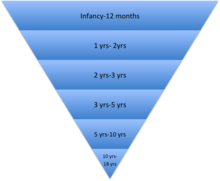User:Ddj025/sandbox
Evaluating Wikipedia[edit]
List of United States graduate business school rankings[edit]
Evaluating content[edit]
Almost everything is relevant to the article topic. I say this because the article pulled out facts from various magazines and websites that are known to have factual sources. But due to how often the rankings change, this article can be very difficult to be completely factual about. The title alone is distracting because it seems as if this article is based on an opinion. Even though the editor attempted to point out facts, we do not know if any of his sources fabricated the actual facts. There are numerous things that are out of date due to how often these schools perform. I do not think that any additional information could be added to this article to make it more relevant. The information may or may not be factual. The article need to have those few quotations removed. The quotations seem to be direct and copied and pasted. The article is also using information from publish articles which may not be the best idea considering that it is not coming from a scholarly source.
Evaluating tone[edit]
The article seem to be neutral throughout the whole thing but the chart does not accurately represent which school is better than the next. Plus, this article does not display if the ranking between a certain set of numbers or if it is ranked out of how many schools. This article does not appear to be based towards any particular position. I do not think any section was over or underrepresented. All sections had the information there to support the claim. The article just needed to be updated.
Evaluating sources[edit]
There were several links that did not work. When you clicked on a few of them, some of the links took you to a page that no longer existed. There were a few that did support some of the claims. Most of the facts did not have a reliable reference. Most of the information stemmed from news publications that were on their websites. Most of the websites were very biased. The bias was noted when he described each publication that put up the rankings.
Talk Page[edit]
The conversations that were being conducted were more so of editors wanting to fix this article by updating the rankings, adding WikiLinks to everything that needed them and modifying external links. The article was rated list class. It is a part of WikiProjects. It is in dire need of updating considering that the last update was in November of 2017. The discussion is different because of the way things are connected and verified. I see how some pages can come across to some people as pointless information or even biased information based off what was discussed in class. I also see how some editors do not pick up on everything.
Editing an existing article[edit]
Interpersonal communication[edit]
Context[edit]
Context generally refers to the environmental factors that influence the outcomes of communication. This includes the time and place as well as the background of the participants.[1] In any given environment or situation a conversation takes place in, many contexts may be interacting at the same time.[2] To have an in-depth understanding of the interpersonal interaction, the retrospective context and the emergent context must be examined and considered. The retrospective context is defined as everything that comes before a particular behavior that might help understand and interpret that behavior. The emergent context is described as all events that come after the said behavior and which may also contribute to understanding the behavior.[3] Context in regards to interpersonal communication refers to the establishment and control of formal and informal relationships.[4] Generally, the focus has been on "dyadic communication" meaning face to face mutual ideas between two individuals in health communication research with a focus on the patient and the provider.[4] Additionally, interest in the role of families, and occasionally among other key roles in the health care system are all factors on the context of interpersonal communication. When trying to understand the harmony and balance of the behavior, one should be aware of the tone rather than focusing solely on what is actually said in order to understand the other party's perspective. Regardless of how intimate the relationship, people communicate their perspectives and preferences by what is said in addition to their tone of voice, facial expressions, how welcoming they are, and so forth.[5] The language and messages in conversation can be ambiguous if taken at face value but in the English language, how something is said can more impact than the statement itself. Context dictates the structure and constituent view of the conversation and ultimately the relationship.
Developmental Progress (maturity)[edit]


The development of communication throughout one's lifetime is crucial because it is required in almost every aspect of human life. Majority of language development happens during infancy and early childhood. It is very important that infants learn the principles of communication earlier on in their development. The following information can be used to adapt to the specific attributes in each level of development to effectively communicate with an individual of these ages.[6] The amount of communication and language development that happens in different stages of life include:
0-1 Years of Age:
- During the period of infancy, an infant mainly uses non-verbal communication (mostly gestures) to communicate with others effectively In the first period of a newborn's life crying is the only means of communication, which is used to demonstrate their needs and wants. Infants, one-five months old, have different tones of crying that indicate their emotions. Also, within the one-five month stage, the newborn begins laughing. When the infants are six-seven months old, they begin to respond to their name, yell and squeal, and distinguish emotions based on the tone of voice of the mother and father. Between seven-ten months, the infant starts putting words together, for example, "mama" and "dada". These words are simply babbled by the infant, lacking meaning and significance. When the infant turns 12 months of age, they start to put meaning behind those once babbled words and can start imitate any sounds they hear like animal sounds. Verbal communication begins to occur at the age of 10-12 months. It starts with the act of imitating adult language and slowly developing the words "mama" and "dada". They can also respond to simple commands. The non-verbal communication of infants includes the use of gaze, head orientation, and body positioning. This enables them to communicate without the use of language yet displays what they are trying to convey to others. Gestures are also widely used as an act of communication. All these stages can be delayed if the parents do not communicate with their infant daily.[7]
- Nonverbal communication begins with the comprehension of parents and how they use it effectively in conversation. Infants can breakdown what adults and others are saying to them; they then use their comprehension of this communication to produce their own.[8] Infants have a remarkable capacity to adjust their behavior in social interactions. Infant's readiness to communicate completely effects their language development. Variations in the amount of interaction between a mother and her child will effect certain aspects of the infant's language performance.[9]
Bibliography[edit]
Part C[edit]
Social networks[edit]
According to Malcolm R. Parks (2011) in the SAGE Handbook of Interpersonal Communication, interest in social networks has increased over the past decade among scholars in a variety of disciplines. Networks of all kinds consist of nodes and links. The way these concepts are defined varies across disciplines. Interpersonal communication researchers define nodes as individuals and links are conceptualized as the content or frequency of their interaction or the overall strength of their relationship.
The value of network analysis resides in the identification of the larger patterns or structures created by the way network members are connected to one another. The structures both create and reflect a wide range of social phenomena. Interpersonal communication research has traditionally focused on the attributes of message or communicators, as well as attributes of the relationship between the communicators. Taking a network perspective, however, involves focusing on structures of connections among communicators. Rather describing individuals and their personalities, individuals are described in terms of their relative location within a larger social network structure. [10] [11]
I chose Option b. The first source is primary and it is academic. This source goes in depth explaining what it means to have social networks as a discipline. The second source is secondary and its scholarly.
Wikipedia Part A[edit]

[12] I chose this photo because it defines the whole idea behind the original article which is interpersonal communication. The study of communication from one person to the next.
Reference[edit]
- ^ Corbin, C. White, D. (2008). "Interpersonal Communication: A Cultural Approach." Sydney, NS. Cape Breton University Press
- ^ McHugh Schuste, Pamela (2010). Communication for Nursing: How to Prevent Harmful Events and Promote Patient Safety. USA: F. A. Davis Company. ISBN 9780803625303.
- ^ Knapp, Mark L.; Daly, John A. (2002). Handbook of interpersonal communication (3. ed.). Thousand Oaks, Ca. [u.a.]: Sage Publ. ISBN 978-0-7619-2160-8.
- ^ a b Ackerson, L.; Viswanath, K. (2009). "The Social Context Of Interpersonal Communication And Health". Journal of Health Communication. 14 (1): 5–17. doi:10.1080/10810730902806836. PMID 19449264.
- ^ T., Wood, Julia. Interpersonal communication : everyday encounters (Edition 8 ed.). Boston, MA. ISBN 9781285445830. OCLC 904723194.
{{cite book}}: CS1 maint: multiple names: authors list (link) - ^ Reilly, Abigail Peterson (1980). The Communication Game. United States of America: Johnson & Johnson Baby Products Company. p. 1. ISBN 978-0-931562-05-1.
- ^ Ateah, Christine A.; Kyle, Terri; Scott, Shannon D. (2008). Canadian Essentials of Pediatric Nursing. China: Wolters Kluwer Lippincott Williams & Wilkins. pp. 82–84, 108–109. ISBN 978-1-60913-707-6.
- ^ Haslett, B; Samter, W (1997). Children communicating: the first 5 years. Mahwah, N.J.: Erlbaum.
- ^ Reilly, Abigail Peterson (1980). The Communication Game. United States of America: Johnson & Johnson Baby Products Company. pp. 1–18, 49–64. ISBN 978-0-931562-05-1.
- ^ Tamir, Lois M. (1979), "Origins of Communication", Communication and the Aging Process, Elsevier, pp. 47–68, ISBN 9780080246215, retrieved 2019-05-06
- ^ Shuter, Robert (2017-01-10), "28. Intercultural new media studies: Still the next frontier in intercultural communication", Intercultural Communication, De Gruyter, ISBN 9781501500060, retrieved 2019-05-06
- ^ "Lethbridge, Thomas Charles, (23 March 1901–30 Sept. 1971)", Who Was Who, Oxford University Press, 2007-12-01, retrieved 2019-05-06
